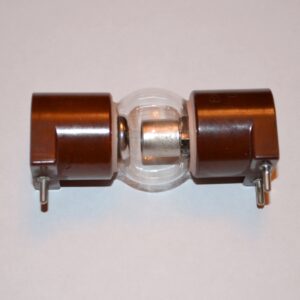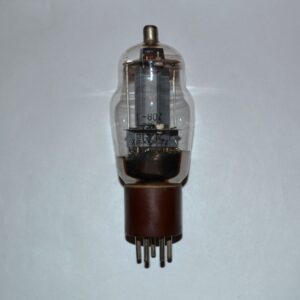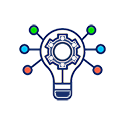decatron
Two-pulse gas-discharge switchboard decatron A-101 in a glass design, with a base.
Designed to work in control and measuring equipment and for contactless
switching circuits in electronic devices.
Structurally, the decatron is made in the form of a glass gas- filled balloon,
in which the anode is located in the form of a disk, 30 cathode pins are located along its periphery.
When a series of pulses is applied, the discharge seems to run through all the cathode pins.
Filled with an inert gas with a deionizing impurity.
The cathodes are cold and inactive. They work in any position.
The maximum permissible operating modes of the A101 radio lamp.
Working current, mA—0,3 – 0,45
Power supply voltage, V, not less than—420
Offset voltage at the control electrodes, V—36 – 44
Overload current, mA, not more than—1.5
The amplitude of the control voltage pulse, V—135 – 200
The amplitude of the output pulse, V, not more than—20
Overload time, min., no more than—5
Pulse duration of the control voltage, mks—200 – 1000
Counting speed, Hz—0,01 – 1000
Ready time (in the dark), s, no more than—5
Glow color—orange-red
Decatrons were used in control and measuring equipment:
1. In generators of rectangular oscillations with an exact half-wave ratio.
2. For frequency division in time stamp generation schemes and in synchronization schemes at multiple frequencies.
3. In quartz oscillators of highly stable frequencies to obtain stable lower multiple and non-multiple frequencies.
4. In electronic and loop oscilloscopes, when obtaining a time grid to determine the time parameters of processes.
5. In the generators of the exact variable frequency of the stepped form to obtain vibrations of sound and infrasound frequencies.
6. In generators of rectangular oscillations with an exact half-wave ratio.
7. In frequency meters-phasometers: to determine the phase difference of two low frequency voltages,
to measure the time between two electrical pulses, to measure the period of frequency fluctuations with increased
accuracy.
The use of decatrons made it possible to significantly simplify the design of counting and other circuits,
moreover, the results of the calculation could be read directly by the position of the discharge section,
visible through the glass cylinder of the device.











